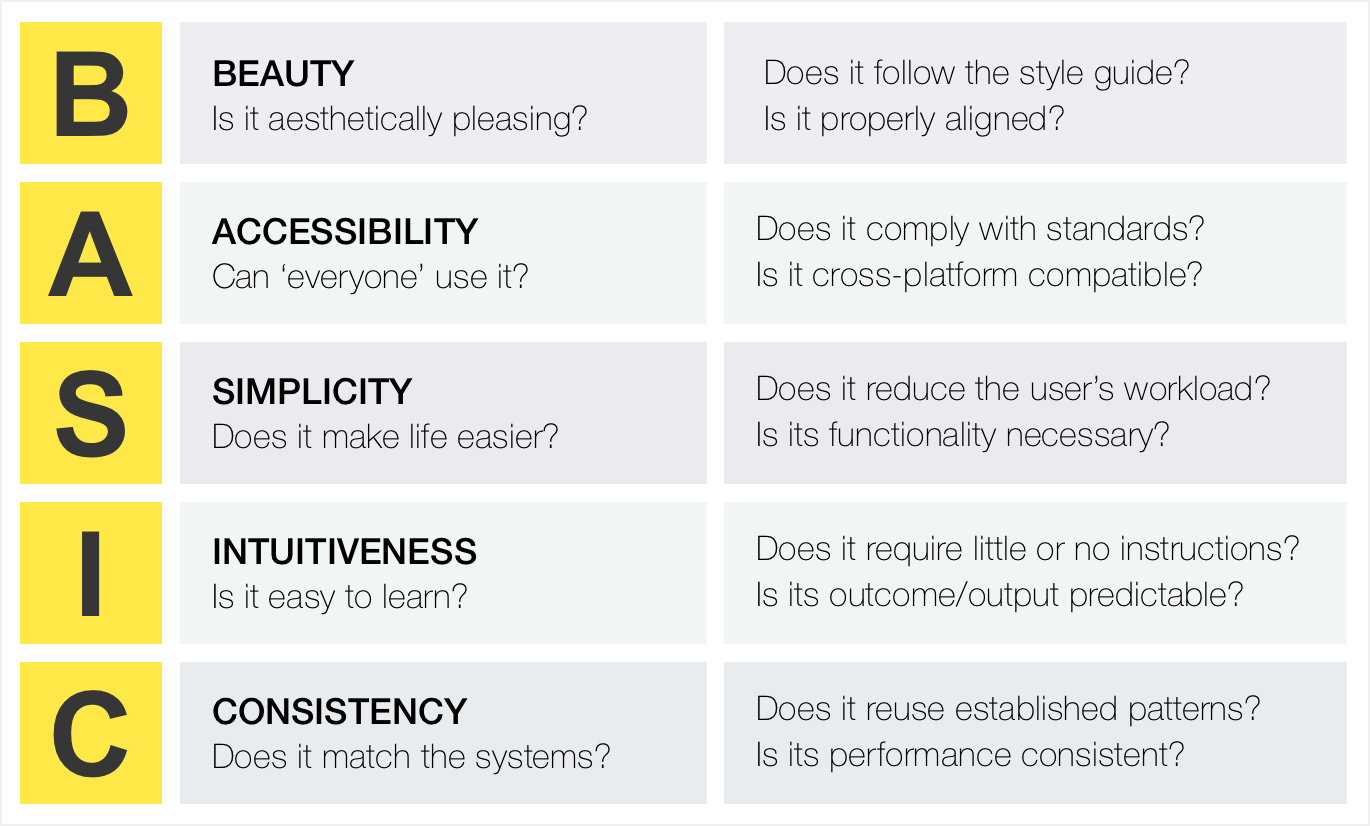BASIC UX
A Framework for Usable Products

BASIC UX is a set of common principles
that test something’s overall user experience.
Beauty
It is aesthetically pleasing?
The look and feel of a product is an important part of its overall user experience. A visually appealing design is perceived as being easier to use than an ugly one (Aesthetic-Usability Effect). Designers should establish style guides and design specs to set the standard for a product’s look and feel. A few minor details in some cases can make a design look ‘off’ and make the product feel ‘broken.’
Questions to ask
- Is it aesthetically pleasing?
- Does it follows the style guide?
- Are high quality visuals used?
- Is it properly aligned?
Accessibility
Can ‘everyone’ use it?
A product’s accessibility is the degree to which it is available and usable by people, regardless of ability. Developers must go beyond the ‘average’ user and ensures that those with less ability to move hands effectively, vision impairment/blindness, and other disability are also able to use the product.
Questions to ask
- Can ‘everyone’ use it?
- Does it comply with standards?
- Is it cross-platform compatible?
Simplicity
Does it make life easier?
The time it takes to make a decision is proportionally related to the number and complexity of choices (Hick’s Law). Simplicity should be the deciding factor when choosing between two identical designs (Ockham’s Razor). Designers should create user interfaces that distill the options to only what is needed to perform the user’s task. Visually, this means balancing use of space and alignment to create associates rather than complex graphics and styling. For language, this means reducing redundancy, minimizing passivity and filler words. Overall, simplicity also reflect on a products usefulness to reduce the workload for its user; does it make their life easier/simpler, or does it add complexity and work?
Questions to ask
- Does it reduce the user’s workload?
- Is it free of clutter and repetitive text?
- Is its functionality necessary?
Intuitiveness
Is it easy to learn?
Intuitiveness is about on how "learnable" a product and its features are. Very few things are innately intuitive like breathing. The critical point here is that a product can be learned and that the user does not need to relearn its functionality over and over again. Also, this learning should be as simple as possible so that understanding the product is not a large obstacle to using the product itself. Affordance is a key aspect of intuitive design. Like the color of links or the shape of buttons; these design techniques give clues to the user about what the elements can do. It’s also import to realize that most people spend most of their time with other products; so building upon learned patters is key.
Questions to ask
- Is the functionality clear?
- Can the user achieve their goal with little or no initial instructions?
- Is the task easily repeated by the user without further instruction?
- Can the user predict the outcome/output?
Consistency
Does it match the system?
Consistency is the thread that holds a product's user experience together. A beautiful product is consistent. An accessible product is consistent. A simple product is consistent. An intuitive product is consistent. In UX — consistency is the thing that separates frustrating chaos from cohesive harmony. It is important that design colors, spacings, fonts and alignments are consistent throughout the product. Designers should reuse existing and learned elements in the system whenever possible. Forms should have consistent alerts, labels, validation, and action behaviors. Navigation should be consistent and predictable. A dependable product performs consistently for a user every time. This builds trust and assurance between the user and the product's functionality. If consistency is lacking then the entire UX will be as well.
Questions to ask
- Does it reuse existing patterns/designs?
- Is its language, images, and branding consistent with the system?
- Does it appear in the right place at the right time?
- Does is perform consistently every time?


